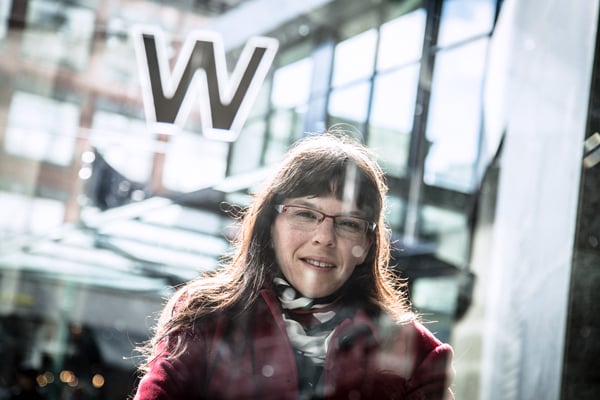Vision Vancouver councillor Andrea Reimer spent time during her teen years living on the streets of downtown Vancouver and in some of its more notorious single-room-occupancy hotels. So the city's controversial new $1-billion 30-year plan for the Downtown Eastside is more than just another policy file -- it's personal.
Sitting in the East Van Roasters café beside Pigeon Park last week, Reimer confessed to being angry with critics who are outraged that the new Downtown Eastside Area Plan proposes to preserve one small 12-block area of the Downtown Eastside for social and rental housing.
City planning staff have dubbed this area the Downtown Eastside Oppenheimer District (DEOD); it's the heart of the low-income neighbourhood and is based along Hastings Street, bordered by trendy Gastown to the west and Strathcona to the east. Condo ownership would be severely restricted in this planning sub-area and new developments beyond current density must be 60 per cent social housing and 40 per cent rental.
The plan would still allow for new condos to gentrify Hastings Street from Strathcona to Clark Drive, as well as many other parts of the inner city neighborhood. The 60/40 split in the DEOD "is a very innovative way to control land speculation," said Reimer. "It doesn't build social housing. But it makes it much more possible for social housing to be built."
But frustration with those who say the private market should have even more sway in the Downtown Eastside is not what brought tears to Reimer's eyes and made her voice crack during our talk.
The emotional reaction came when Reimer talked about the people she met in the Downtown Eastside as a teenager.
She figures fewer than a hundred of the Downtown Eastside's 18,000 residents are involved in the street disorder that goes on. Most of them just "fell through one crack, and then another."
"How many times did I meet guys who lost their job, got divorced, had gambling addictions, were injured at work and were on pain medications they couldn't get off of. People with brutal childhoods. It's amazing that some of them are still walking around, right? And some of them aren't."
Reimer was momentarily overcome by her memories but quickly regained her composure. "I realize in doing this work that I have a lot of unresolved trauma around some stuff, right? And it's all come roaring back over the past couple of weeks in trying to defend this plan.
"I feel like I'm defending friends and family who didn't make it out."
Plan calls for $800 million to social housing
The goal of the new Downtown Eastside Area Plan, which goes to council Wednesday, is to defend the neighborhood's low-income community while promoting new density and economic growth in the inner city.
The plan calls for 4,400 new social housing units to be built within the Downtown Eastside over 30 years, another 3,350 units elsewhere in the city, rent subsidies and upgrades to the SRO hotels.
But the report from the city planning department is about more than subsidized housing for the poor. It also proposes 3,000 market rental units and 8,850 new condos for middle-income earners – targets which could eventually give the area a more middle-class character without pushing out the poor. Condo buildings near Clark and Hastings Streets could be 12 to 15 storeys high.
"Over time we'll move from the current 67 per cent low-income in the Downtown Eastside to about 50/50," said Reimer. "But that social mix is only possible if you first secure the low-income assets and build around them."
The plan suggests that $800 million should be spent over the next 30 years on social housing. The city believes that $300 million in community amenity contributions and other fees could be collected from developers building new and bigger buildings in the Downtown Eastside, with most of those fees going to social housing.
In this way, the growth of market accommodation on the Hastings Corridor, Gastown, Victory Square, Thornton Park, Chinatown and Kiwassa -- what some might call gentrification -- can be used to secure housing for the poor. Another $200 million would come from the city, according to the staff report, and another $500 million from the provincal and federal governments.
Critics like real estate consultant Michael Geller and Vancouver Sun columnist Shelley Fralic say the restrictions on condos will prevent the Downtown Eastside from becoming a truly mixed-income neighborhood. Currently, 60 per cent of its residents are considered low-income; the median income is only $13,700.
Geller called the Downtown Eastside a "low-income ghetto" that needs to be "normalized." Fralic called it a "cesspool," complaining that "one does grow weary of the attention paid, and money spent, on the thousands of others in the DTES who have willfully chosen crime and addiction as their life's calling."
Reimer said that Geller and Fralic are "insensitive" to the majority of Downtown Eastside residents who do not engage in crime or street disorder. "What I would also say is that this plan absolutely provides for a mixed-income community. But not at the expense of the low-income residents."
Poorest still not protected, say critics
The plan reflects the city's long-standing goal of revitalization in the Downtown Eastside without displacement. This strategy has long been criticized by many far-left activists for not doing enough to protect the area from gentrification.
Each new hipster bar and high-end restaurant in the heart of the Downtown Eastside has been assailed as proof that Vision Vancouver is not protecting the poor from market-driven neo-liberalism. This war over gentrification peaked last year with the protests outside the upscale Pidgin restaurant at Carrall and Hastings.
Reimer shares some of the concern over gentrification, although she doesn't endorse the activists' tactics. Before joining me Reimer had met with anti-poverty activists at the Carnegie Centre, many linked to the Carnegie Community Action Project, to discuss their research showing how rents in the area have moved well beyond the shelter rate of $375 for a single person on social assistance.
"The shelter rate problem is real," said Reimer, arguing that an escalation in land values has led to rising rents. "Revitalization has taken place that has led to displacement."
Reimer said that even a highly-praised mixed-income project like Woodwards, which has condos and social housing, would be harmful in the DEOD because it would drive up land prices. "Although the mix would be desirable in other parts of the Downtown Eastside."
Activists are pleased that the city wants to limit condos. They have longed called for a condo-free "Social Justice Zone" in the DEOD.
Critics like Geller say the left-wing activists hijacked the Local Area Planning process and that politicians like Reimer and planners fell victim to a "Stockholm syndrome."
The far-left, however, is not rushing to praise the Vision Vancouver council for showing its social-democratic side by putting curbs on private ownership in one part of the Downtown Eastside.
Activists, many of them tied to the Coalition of Progressive Electors, have complained that only about one-third of the proposed 4,400 new units will be affordable to people on welfare.
Kevin McNaney, assistant director of planning for Vancouver, said the city has limited levers to influence affordability. "This plan is simply doing what it can in delivering a very aggressive number of social housing units in a very creative way. But it still requires provincial and federal intervention to help with affordability levels."
Million dollar question: Will province, feds pitch in?
Critics from both the right and the left argue that the plan will fail because it hinges on senior government support that won't materialize. Rich Coleman, the minister in charge of BC Housing, has said that province doesn't build social housing units anymore and instead helps non-profit housing providers.
City officials, however, remain optimistic about provincial assistance, noting that Coleman has talked about providing rent subsidies.
"I have 1,600 rent subsidies that I need to find for this plan," said Reimer. "If those rent subsidies exist they provide more opportunity for developers to think about the immediate chance of building rental."
Reimer said the plan's targets for the first 10 years of the plan, including the creation of about 1,400 social housing units, are achievable without serious funding from Victoria or Ottawa.
"We feel we can meet our 10-year targets without a single new dollar from senior governments," said Reimer. "But we can't maintain that over 30 years."
Former Vancouver planning director Brent Toderian said that a policy favoring rental housing over condos in the DEOD is probably warranted. But he is uncertain whether it can work without substantial funding from senior levels of government.
"I don't begrudge the city taking a very protective approach to the DEOD, though it's not a policy I would want elsewhere in the Downtown Eastside.
"But I am hopeful that it is not an effective moratorium (on condos) in the DEOD and that developers will take advantage of having market development at the base density and do additional density in market and social rental.
"It suggests the potential for a mix if it can be made viable – but that is the biggest if."
Toderian said the staff report's biggest mystery is the economic analysis on the 60/40 rental scenario in the DEOD by Coriolis Consulting, an outside consultant hired by the city.
"To me the real question, which I haven't seen answered, is: What are the conclusions of that economic analysis? Are we creating a policy where there will be a reasonable number of properties and sites that can take advantage of the policy and actually deliver rental and social housing?"
Reimer said the planning department isn't prepared to release the Coriolis analysis because the data on potential land values could undermine the city's ability to promote rental development in the DEOD.
"If we released the exact range of what we were looking at paying for land -- which is what the Coriolos report does -- then the maximums in that report would become the minimum current landowners would set as the asking price," said Reimer. "Put another way, no one goes into a real estate deal letting a seller know the maximum they can pay."
The Downtown Eastside, in 20 years
City planner McNaney said that many non-profits have expressed interest in developing rental buildings in the DEOD under the proposed new zoning. These projects can be made more viable, he added, by relaxing rules on parking requirements, development cost levies and allowing units to be as small as 250-square feet for studios. Using wood framing rather than concrete could also boost affordability, he added.
If the plan works, what kind of place could the Downtown Eastside be in 20 years?
Reimer believes that people will eventually stop seeing the area through the dispiriting lens of the Hastings and Main street scene. She thinks the Downtown Eastside can become more like Grandview-Woodlands, the East Vancouver neighborhood where she lives.
"Grandview Woodlands has a lot of low-income folks, almost as many as the Downtown Eastside. Some of the social indicators are very concerning, but everyone loves the community.
"People want to go there and participate in events like car-free days or they want to go to the cool shop that sells this or that. It's been able to maintain a healthy economic and social mix with a healthy set of community services.
"There is no reason the Downtown Eastside can't do the same." ![]()
Read more: Housing, Municipal Politics
















Tyee Commenting Guidelines
Comments that violate guidelines risk being deleted, and violations may result in a temporary or permanent user ban. Maintain the spirit of good conversation to stay in the discussion.
*Please note The Tyee is not a forum for spreading misinformation about COVID-19, denying its existence or minimizing its risk to public health.
Do:
Do not: